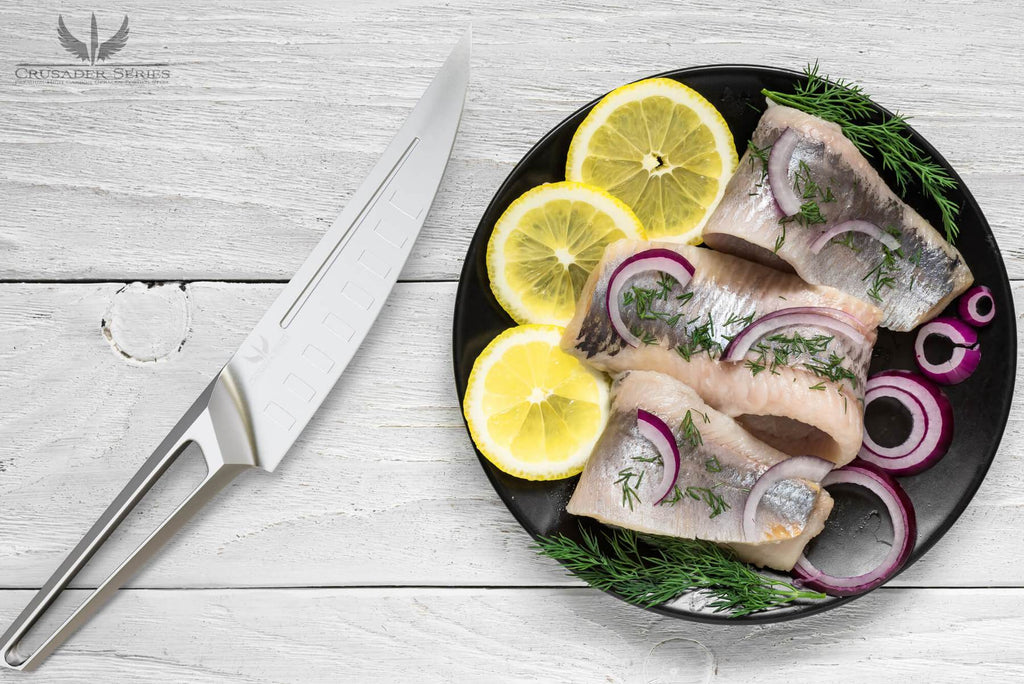
Crusader Series 6.5″ Fillet Knife – NSF Certified
- Material — Pick a blade that won’t rust easily, and can last you forever.
- Thin, Flexible Blades — Slice through the fillet with ease, and make precise cuts.
- Sharp-Edged Blades — Pierce the fish and remove the fish bones intricately.
- Blade Length — The optimal blade length for a fillet knife varies by fish. Check out the table below.
- Handle Type—Choosing a handle that comfortably fits into your hand is essential. It allows for a firm grip.
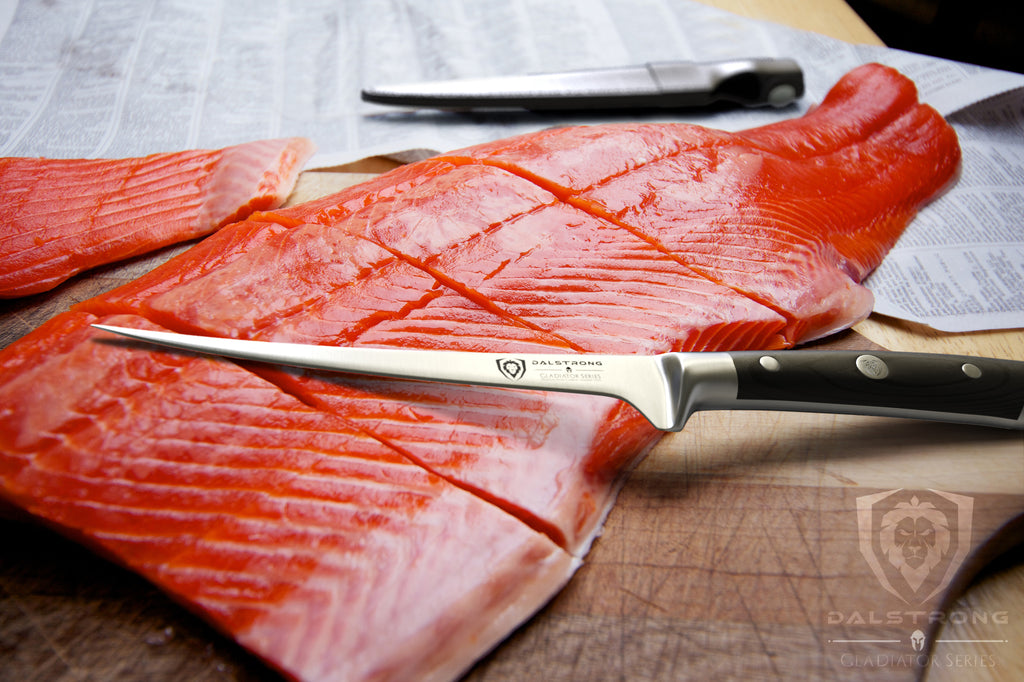
Gladiator Series 7″ Flexible Fillet Knife
Let me preface this by saying I’ve only gotten into fish in the last 6 years or so (I’m 33 at the time of writing this). Now, before you rush to judgement, I remind you I live in a country that is globally known for its meat and people here will prefer beef over just about anything. Sad, right? But those are the facts.
That’s why, when I first attempted to cook my first fish at home, I was disappointed at the fact that I did not own the proper tools to process it. Longer story short, I ended up cooking the entire fish but it felt like cheating, in a way. I couldn’t help but feel that something was missing so, after a quick online research process, I went ahead and ordered myself a fillet knife.
Filleting, for those of you who don’t know, is basically separating the flesh of the fish from the bone. This is achieved by making smooth, precise cuts along the fish’s backbone, from the tail to the head. Initially, it might sound like a daunting task but a fillet knife can make the job way easier thanks to its flexible yet robust blade, giving you more control over the entire processing endeavor.
And while its raison d’etre might be filleting fish, the fillet knife should also be your go-to tool for the earlier stages of the fish preparation process, aka de-skinning and deboning. Other culinary tasks such as whipping up poultry fillets, producing ultra-thin slices of carpaccio meat, and even deveining shrimp are also among the things a filleting knife can excel at.
So, you see, when you invest in a quality fillet knife, you’re actually investing in a highly versatile tool that will greatly enhance your entire cooking process.
But enough of the chit-chat, let’s get down to business. Here’s everything you need to know about what makes a good fish fillet knife.
- What makes a good fish fillet knife?
- What is the best knife for filleting fish?
- What is a filleting knife used for?
- What is the difference between a fillet knife and a boning knife?
- What kind of knife do you use to cut fish?
- Dalstrong Film – The Fishmonger & The Sea
Table of Contents
- 1. What makes a good fish fillet knife?
- 2. What Is the Best Knife for Filleting Fish?
- 3. What Is a Filleting Knife Used For?
- 4. What Is the Difference Between a Fillet Knife and a Boning Knife?
- 5. What Kind of Knife Do You Use to Cut Fish?
- Frequently Asked Questions
- 6. Dalstrong Film – The Fishmonger & The Sea
- SHOP FILLET KNIVES TODAY
1. What makes a good fish fillet knife?
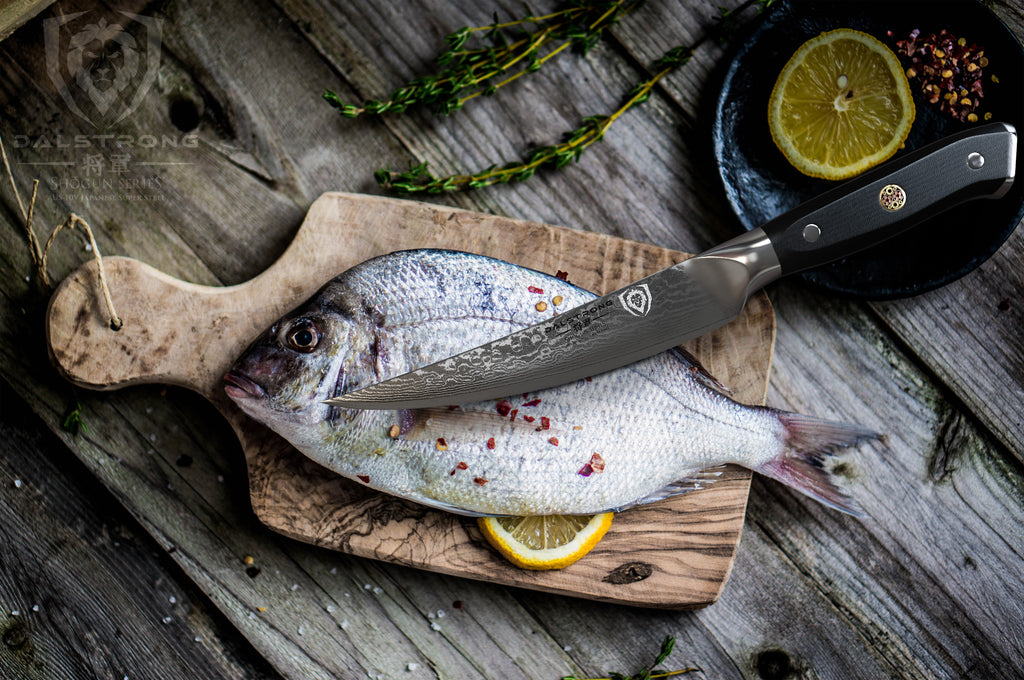
Shogun Series 6” Fillet Knife
There are several aspects that you want to look out for in a good fish fillet knife. These include:
- Material — Pick a blade that won’t rust easily, and can last you forever.
- Thin, Flexible Blades — Slice through the fillet with ease, and make precise cuts.
- Sharp-Edged Blades — Pierce the fish and remove the fish bones intricately
- Blade Length — A cheaper blade might be good for small-fry but you want something that can handle all manner of catches.
- Handle Type—Choosing a handle that comfortably fits into your hand is essential. It allows for a firm grip.
Material
You may only be using your knife at home, but a key thing to remember is: fillet knives are also likely to be used on a fishing expedition. This means they’re going to be exposed to saltwater.
You might be wondering how that’s relevant?
All fillet knives should be corrosion-resistant because of this. A high-carbon stainless steel blade ensures that your knife remains in prime condition, even if it gets wet.
Cheaper knives do sell themselves as being made out of stainless steel, but you’ll find they’re less brittle and lacking the high-carbon the higher end knives offer. These will rust more quickly and lose their sharp-edge.
It’s one of the first aspects you should look for in picking a good knife.
Thin, Flexible Blades
The keyword here is control, and this is something often overlooked. Your knife needs to be thin and flexible, so you can make clean precision cuts.
Imagine trying to do that with a cheap and thick knife.
You’ll likely tear the flesh, and snap the fish’s bones as you make the cut — in turn, that makes it more liable those bones will get lost and end up on your plate!
You’ve found the perfect blade. It’s made of the highest carbon steel, it’s thinner than a piece of string, yet when you go to make your cut, it hardly leaves a mark on the fish!
That’s because you need a sharp-edged blade.
It says that an ideal fillet knife’s edge will have an angle of 12-17 degrees. It’s one of the finer bevels.
A fillet knife needs to be sharp so you can make a smooth cut, just like butter!
It also helps with the fish bones, too. If you spot an elusive bone inside your fish, you wouldn’t want to tear at it with a blunt blade. That could ruin the entire filleting process.
You want to get underneath the bone with a fine point and get it out with ease.
That’s why you need a sharp knife.
Blade Length
It’s easy to overlook the blade length.
You pick up a knife and assume it’s good for the job. 9 times out of 10, it probably is.
However, with a fillet knife, you may be making your life more difficult.
While smaller sized knives allow for more flexibility, when filleting large fish you need a longer blade.
We’ve made a handy guide to help you:
Knife Length Fish Type 4-6” inch blade. Perch Trout Walleye Pan Fish Mackerel 7-8” inch blade. Pink Salmon Salmon 8”-9.5” inch blade. Codfish Tuna Catfish Halibut
Having two or three blade sizes available is a brilliant idea, as you’ll always be prepared — no matter what type of fish you plan to cook!
Knife Handle
Similar to the length, another aspect often overlooked is the handle. Luckily, however, this one is a matter of preference!
Choosing a handle that comfortably fits into your hand is essential. It allows for a firm grip.
Remember: A firm grip means better control. Better control means a better cut.
These are the main three different types of handles available on the market:
- Wood — Comfortable to hold and very sturdy. Slippery when wet.
- Rubber — Better grip than wood, easier to clean. Not as sturdy as wood.
- Plastic — Better grip than wood, easier to clean. Not as sturdy as wood.
2. What Is the Best Knife for Filleting Fish?
As you might’ve inferred from my lengthy preamble, the best knife for filleting fish is, wait for it, the fillet knife. Featuring a lightweight blade that gently curves from the handle to the tip, the fillet knife is the best suited knife to turn a whole fish into a series of longitudinal strips of flesh also known as, yes, you’ve guessed it, fillets.
With a blade length ranging from 6 to 11 inches, this member of the boning knife family is pretty much the only tool you’ll need to de-skin, debone, and filet your freshly caught fish like an actual pro.
In terms of variety, there are two main types of fillet knives out there that you can easily find on any online retailer:
- Japanese-style fillet knives, usually called deba, which are less flexible but extremely sharp thanks to their single-beveled blade (it’s only sharpened on one side).
- On the other hand, Scandinavian (also known as German) fillet knives are also popular, featuring a double-beveled blade with a heftier feel.
At the end of the day, there is no right or wrong when choosing between these two varieties. It all comes down to preference—Japanese fillet knives offer more precision at a granular level but Scandinavian fillet knives are sturdier and therefore better suited for outdoor activities.
If you’ve made it this far, we assume that you might’ve done some research on your end, trying to determine which fillet knife to finally purchase. You might’ve read about Bubba Blade or Rapala, known for their state-of-the-art folding fillet knives and fishing knives. And while we encourage you to follow your heart, we’re not here to tell you what you already know.
We take it for granted that you wouldn’t be reading this article if you weren’t looking for something different, something that could both spice up your kitchen and accompany you on all of your trips and excursions. A unique fillet knife that looks good and, most importantly, feels good.
For that reason, we handpicked a few items from Dalstrong’s wide assortment of fillet knives to offer you a couple of forward-thinking solutions to your current filleting dilemma.
Let’s get started!
1. Filet Knife 6″ | Shadow Black Series | | NSF Certified

There’s no denying it, the Shadow Black Series 6” Filet Knife is one mean-looking knife. Its pitch-black titanium coating makes it look like something Batman would use on his fishing trips. Skin, bone, sinew—nothing stands a chance against its 7CR17MOV-X vacuum-treated steel blade, painstakingly hand sharpened to 16-18° per side for optimal performance.
Pros:
- Peerless design.
- Black, non-reflective titanium-nitride coating for corrosion-resistant, non-stick properties.
- Features an ergonomic handle for maximum comfort.
Cons:
- At 6”, it might not be the best option for working with larger fish.
- Its unique looks might not be for everyone.
2. Curved Fillet Knife 6″ | Gladiator Series

The Gladiator Series’ 6” Curved Fillet Knife is a true all-around performer. From filleting fish and poultry to finely mincing onions and shallots, the versatility of this excellent knife knows no boundaries. Forged from a single piece of high-carbon German ThyssenKrupp steel, its blade is designed for laser-sharp precision.
Pros:
- Beautiful hand-polished finish.
- Excellent edge retention.
- Comes with a PerfectFit Dalstrong Sheath.
Cons:
- Its design is a bit more conservative than other knives on this list.
- Some cooks might prefer a thinner fillet knife blade.
3. Fillet Knife 6″ | Delta Wolf Series
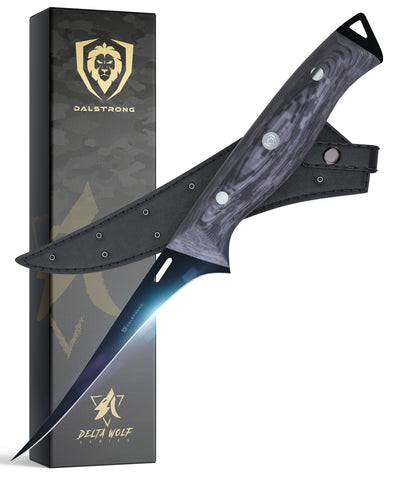
Don’t be fooled by its size, the Delta Wolf Series 6” Fillet Knife is one ruthless performer. Inspired by the Special Operations Force of the same name, it features a high-carbon 9CR18MOV steel blade with a narrow tip that will allow you to filet, trim, de-bone, de-skin, and butterfly with minimal effort. Whether in your kitchen or in the great outdoors, this stunner of a knife is sure to turn heads wherever you go.
Pros:
- Edge is painstakingly hand sharpened to 8-12° for optimal performance.
- The triple-riveted G10 camo handle is designed to withstand the most extreme conditions.
- Comes with a gorgeous PU Leather Sheath.
Cons:
- Some outdoorsy cooks will prefer a slightly longer knife to work with large fish.
- Its stealthy looks might not be everyone’s cup of tea.
4. Shogun Series 6″ Fillet Knife
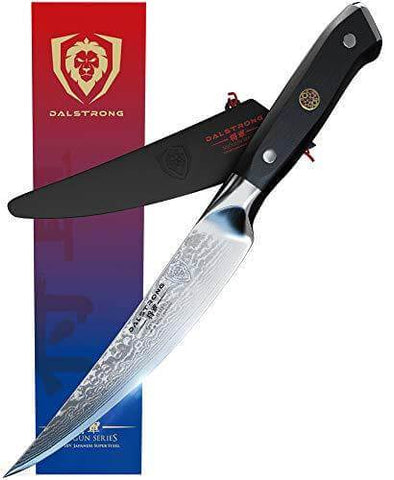
A part of Dalstrong’s very own Shogun Series, this 6” fillet knife marries centuries of Japanese knife making knowledge with modern technology to superb results. With a blend of Japanese high-carbon AUS-10V steel and 66-alternating layers of SUS410 damascus, its blade offers the perfect balance between maneuverability and strength.
Pros:
- Stunning Tsunami Rose pattern on the blade.
- Nitrogen cooled for enhanced harness, flexibility and corrosion resistance.
- G-10 Garolite handle adorned with a classy copper mosaic pin.
Cons:
- Its price point might be a little high for casual home cooks.
- Believe it or not, more conservative chefs will prefer a clean stainless steel finish as opposed to the Damascus steel’s distinctive pattern.
5. Fillet Knife 6.5″ | Crusader Series | NSF Certified

Last but not least, we have the Crusader Series’ 6.5” Fillet Knife. Sporting a minimalist design inspired by medieval swords, this knife will become a trusted ally in your kitchen for all things filleting. Built from a single piece of German-made ThyssenKrupp stainless steel painstakingly sharpened at 16-18 degrees per side, the Crusader is one stellar piece of craftsmanship that will stand the test of time.
Pros:
- Full tang blade for strength and robustness.
- Its seamless transition from the blade to the handle makes it super hygienic and easy to clean.
- Comes with a handcrafted Acacia wood magnetic sheath to keep your knife secured and in place.
Cons:
- Some folks prefer the feel of a traditional wooden handle.
- Its modern looks might be a turnoff for more conservative chefs.
3. What Is a Filleting Knife Used For?
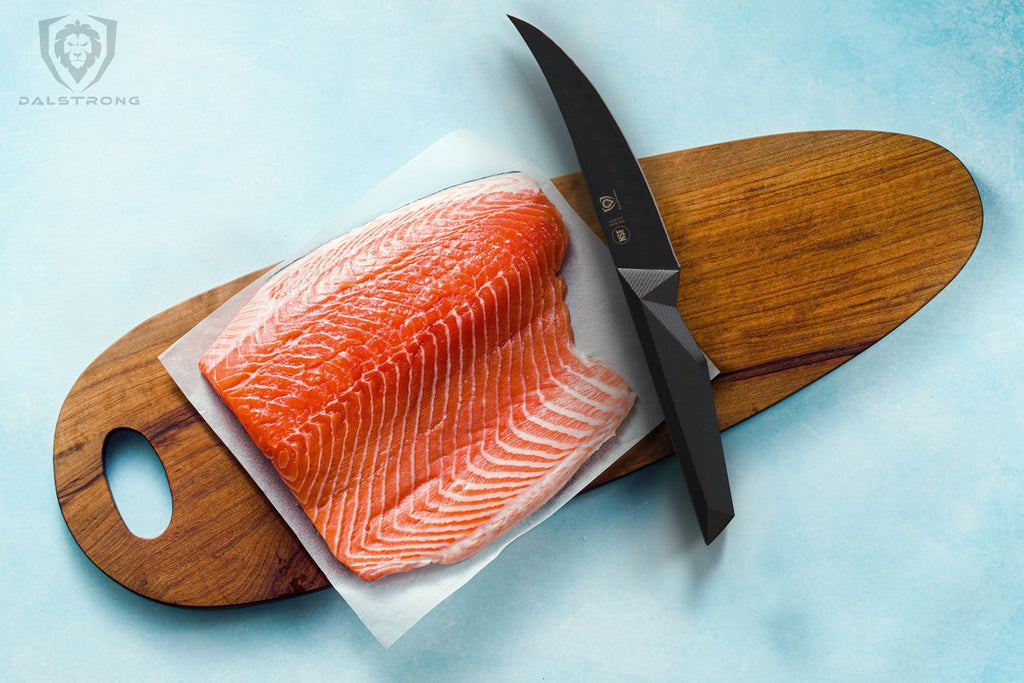 Fillet Knife 6″ | Shadow Black Series
Fillet Knife 6″ | Shadow Black Series
Like we established before, a fillet knife’s main purpose is to produce thin strips of flesh from an entire fish known as fillets. Due to its flexible blade, the fillet knife can cut around the contour of the bones, joints, and skin, making sure nothing goes to waste.
But far from being a one-trick pony, the fillet knife has many aces up its sleeve. Some of the things you can also do with a filet knife include:
- De-bone, filet, and remove the fat from a whole chicken.
- If you don’t own a meat slicer, the fillet knife can act as a decent substitute to get ultra-thin slices of beef.
- Since this type of knife is specially designed to work with fish, it can also come in handy when removing the scales and removing all of the internal organs. This process is also known as cleaning.
- Cut, slice, and peel fruits and vegetables.
- Create sophisticated garnishes for your salads and cocktails.
Pro tip: If you want to look cool while filleting fish for a fancy dinner at home, check out our collection of aprons.
4. What Is the Difference Between a Fillet Knife and a Boning Knife?
While there might be some overlap between these two, the truth is that they serve two entirely different purposes.
Let’s start with the specs:
Boning Knives
- Designed to separate bones from meat and fish.
- Average blade length: between 5 and 7 inches.
- Type of blade: usually flat with a straight and slightly curved tip.
- Removes meat from heavy bones or tiny bones from fish.
- Slightly thicker than fillet knives.
Fillet Knives
- Thinner and more flexible than most other knives.
- Average blade length: between 6 and 11 inches
- Type of blade: features a gentle upward curve that ends in a sharp curved tip.
- Perfect for removing scales from a fish without damaging the meat.
- Can’t handle excessive force like a chef’s knife—it’s mostly meant to perform delicate tasks.
To sum it up, fillet knives are a part of the boning knife family but are generally designed to work solely with fish. Their fillet blade is thinner and more flexible than most boning knives, allowing for a greater degree of control. Like we’ve mentioned before, a fillet knife can perform many other tasks but an irresponsible use can dramatically reduce its lifespan and damage the sharp blade.
Boning knives, on the other hand, are a bit sturdier and can easily process larger pieces of beef and game. While they’re considered more versatile than fillet knives, boning knives are not as flexible and will not perform as well with delicate meats such as fish. This requires a level of flexibility and finesse that only the fillet knife possesses.
Pro tip: What’s your sharpening go-to method? Whetstone? Sharpening steel? Regardless of your weapon of choice, this nifty sharpening tutorial covers pretty much all you need to know about keeping your knife blade’s sharp edge.
5. What Kind of Knife Do You Use to Cut Fish?
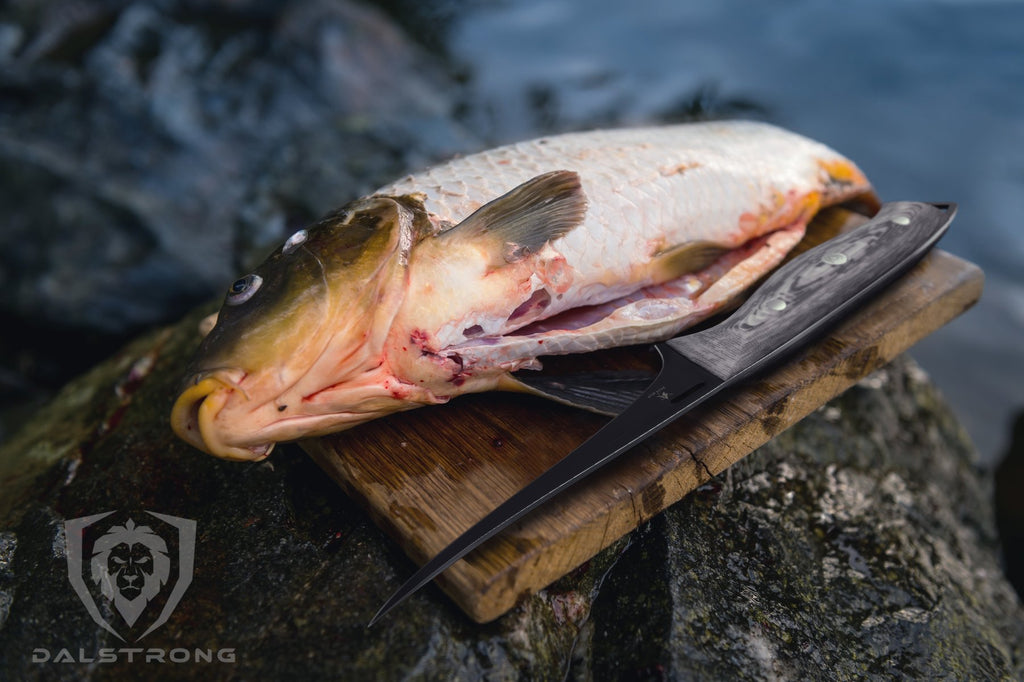
6” Fillet Knife | Delta Wolf Series | Dalstrong ©
There’s just no way around it. Processing fish requires a high quality fillet knife. Your average kitchen knife or chef’s knife just won’t do.
If you want to step up your fish-processing game, you need a fillet knife with corrosion-resistant properties. This is a must, since prepping fish means you’ll be working mostly in wet environments. Most modern high-carbon stainless steel blades will do just fine.
Also, when working with fish, hardness is not so much of a concern. What you need is a thin and flexible blade that can breeze through the fish’s fragile bones and skin without leaving a full-on carnage on your cutting board. A good fillet knife can transform an entire fish into precisely cut fillets with surgical precision.
Note: There are also electric fillet knives that can work just as well as a fixed blade. That said, they’re generally larger, heavier, and more expensive. Now, that wouldn’t be a problem if you were only using it in your kitchen but think about your fishing trips: would you wanna carry around a power source wherever you go? We didn’t think so either.
Frequently Asked Questions
What is the best quality fillet knife?
The best quality fillet knife can vary depending on personal preferences and needs. Factors to consider include the knife’s blade material, sharpness, flexibility, and handle comfort. Brands like Wusthof, Victorinox, and Bubba offer reliable options. An electric fillet knife, like those from Rapala or American Angler, can also be a good choice for efficient filleting. A comfortable handle with a nonslip grip enhances safety and control.
6. Dalstrong Film – The Fishmonger & The Sea
SHOP FILLET KNIVES TODAY
You can also check in with our Expert Knife Finder Quiz and get specific recommendations based on your needs.
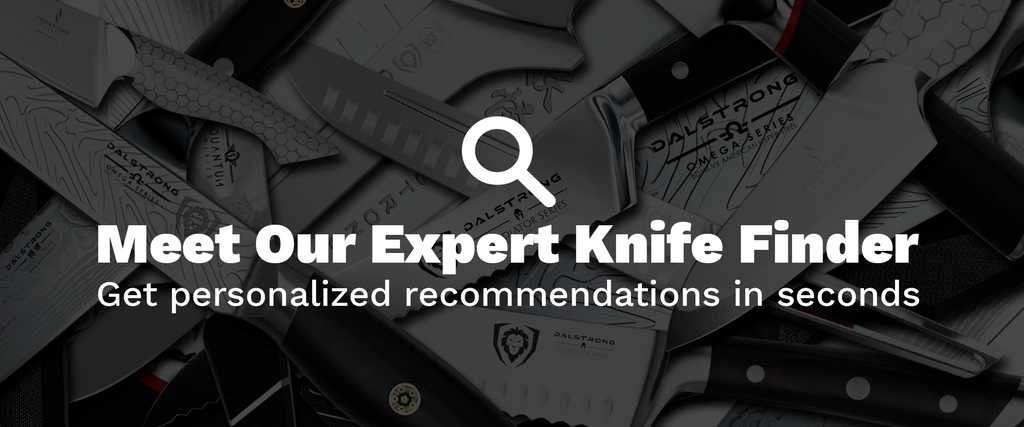
Written by Pablo Perez
When he’s not adding way too much butter to his recipes, Pablo likes to write about knives, music, food, cinema, and all of the other things that make life worth living.








































